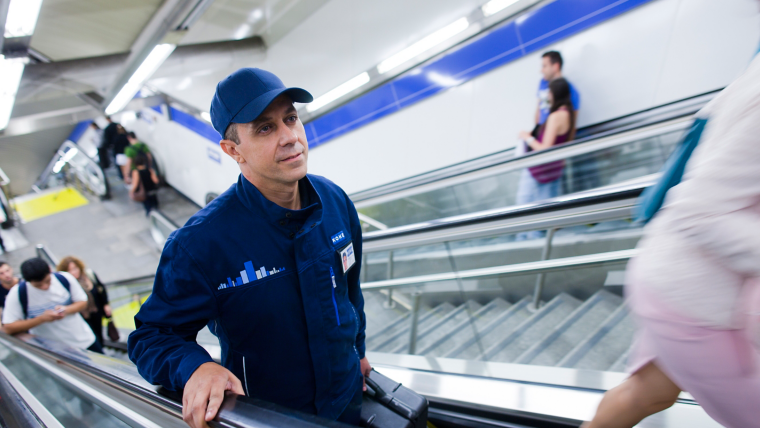-
Based on AI analytics and cloud-connected equipment, KONE has developed a real-time analysis of operating data and operating conditions for escalators. Predictive escalator maintenance makes it possible to detect warning signs of failures or malfunctions, and thus trigger preventive interventions to avoid unnecessary repairs or downtime.
-
- Handrail bearing failure or over-tensioning leading to increased handrail temperature.
- Misalignment or rust in the step band causing increasing noise levels.
- Increased braking distance or speed differences between the handrail and step band, signaling safety risks.
- Stoppages due to electrical system protection or foreign objects entrapped in the step band or comb plates.
- Instability in the drive station, detected through excessive vibration on the gearbox, or oil degradation indicated by rising temperatures.
- If you are experiencing any of these escalator issues, make sure to report them promtly as they are both safety risks and early indication of escalator breakdown."
-
- Unusual noise levels generated by the step band or handrail.
- Changes in braking distance or speed inconsistencies.
- Elevated temperatures in key components such as the handrail or drive station.
- Vibration detected on the gearbox, indicating potential instability.
- Any deviations from standard operating parameters as monitored by predictive maintenance systems.
Escalator predictive maintenance uses sensors to track and gather actionable data on various escalator components and behaviors. By monitoring these indicators, potential issues can be identified early, enabling proactive escalator maintenance interventions to prevent escalator failures and ensure continued smooth and safe operation.
Escalator maintenance | Effortless service and predictive escalator maintenance for any brand
TAILORED MAINTENANCE

An approach that’s right for you
Take care of your loved ones with essential escalator maintenance, or use the latest technology to anticipate problems with predictive escalator maintenance. With a tailored approach and brand-specific experts, we'll help you find the type of service that's right for you no matter what type of escalators you have.
Predictive escalator maintenance
Maximize escalator availability with AI-based data analytics that can anticipate maintenance needs and reduce unexpected repairs. Speed, temperature, vibration and energy consumption are monitored in real time to improve safety and enable carbon-optimized operations. If an escalator stops because of user error, proactive notifications are sent immediately and you will also be notified when it’s safe to restart your escalator.
40%
fewer technical failures over a 2-year period
Do less reactive work for easier planning
360°
lifecycle approach for repairs, upgrades and renewals.
A comprehensive plan for the future
80%
of equipment faults identified proactively
Keep your equipment running smoothly
78%
78% of the main spare parts are already in the van
Less driving for lower CO2 emissions
How can we help you?
Please fill in the form and we'll get in touch with you shortly
Sample form
Frequently asked questions
Learn more about escalator maintenance with helpful answers to common questions.





















